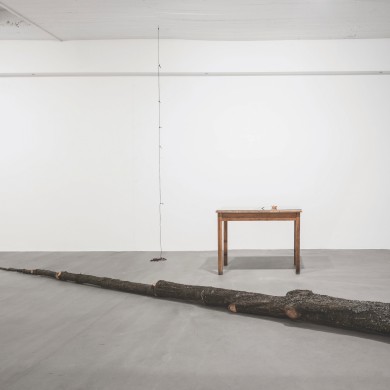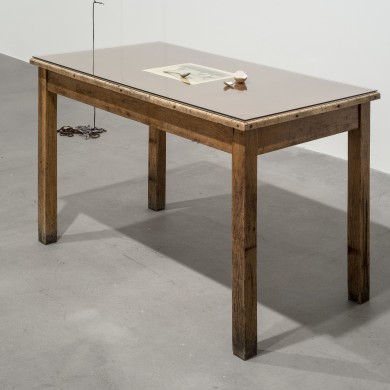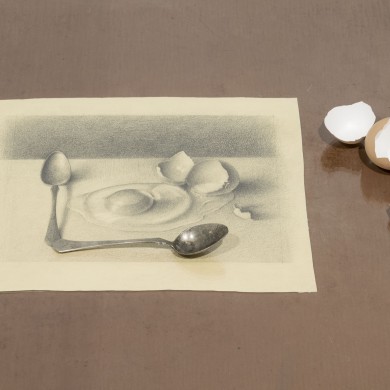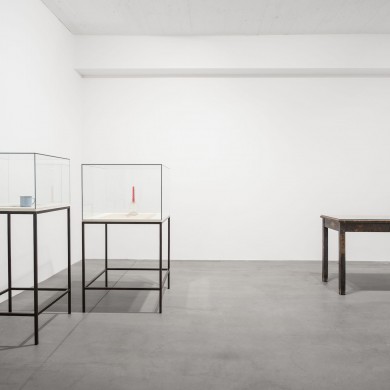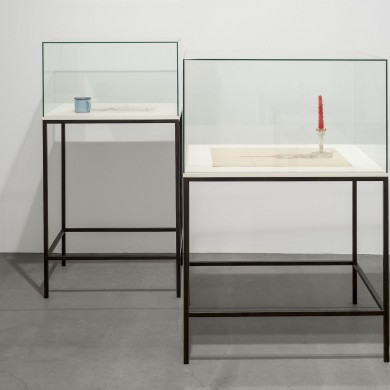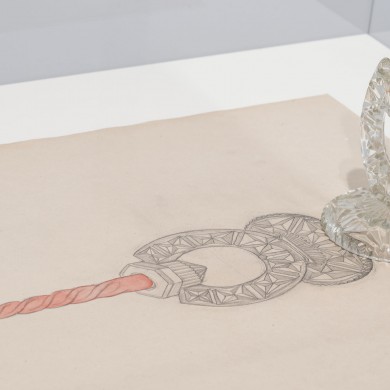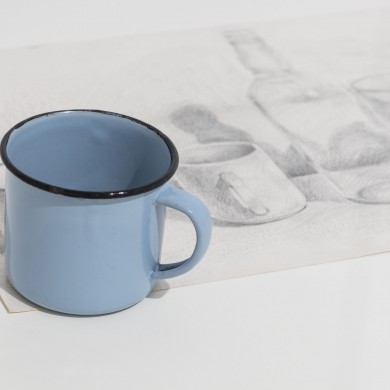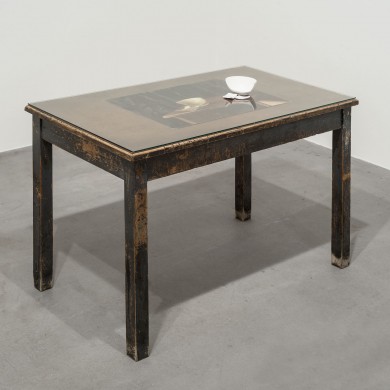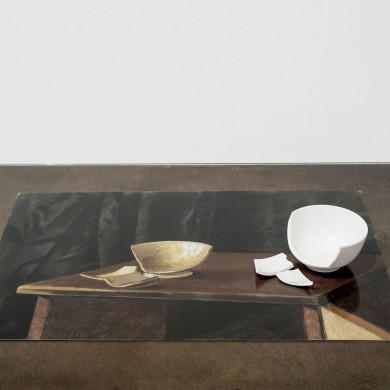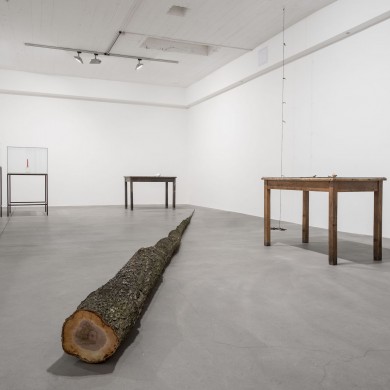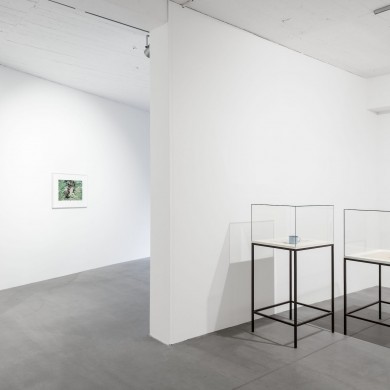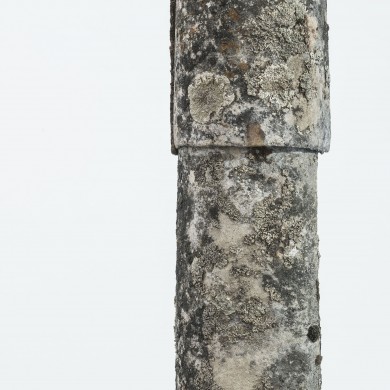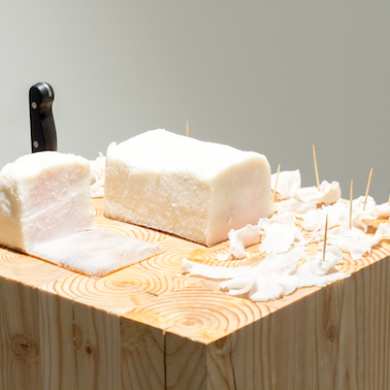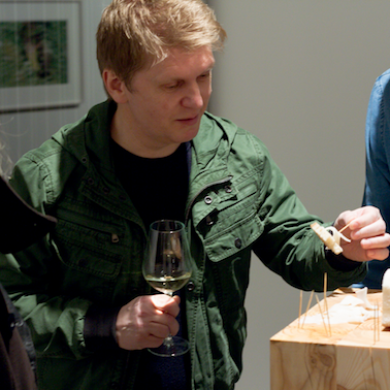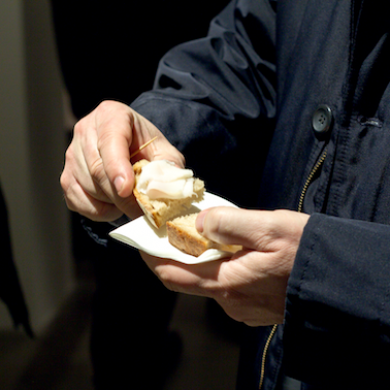SKY GRAVITY
Roman Ondak, Štefan Papčo
19 Jan – 16 March 2018
ZAHORIAN & VAN ESPEN Bratislava
Thomas McEvilley succinctly formulated the change of paradigm in visual art during the second half of the 20th century: “It has been the special genius of our century to investigate things in relation to their context, to come to see the context as formative on the thing, and finally, to see the context as a thing itself” (introducing texts by Brian O’Doherty).
The formative power of the context of objects is important for both artists in the Sky Gravity exhibition: Roman Ondak (1966) and Štefan Papčo (1983). The broad spectrum of the two artists’ themes is compressed in this instance to a single universal: time, which contextualises our being. In art and mythology time is metaphorically represented by flowing, pouring, a flux or a thread; symbolically it is often a river or the trunk of a tree. The riverbed and the rings on the trunk “materialise” time, make it visible. Or more precisely, they show its influence, its reach, its impact, to the extent that we can access these with our limited senses. There are many interpretations of the phenomenon of time in scholarly disciplines: mathematical, astronomical, biological, social, individual. The first three of these define measurability and exactitude; the last two define fluidity, relativity and diversity. What determines the measure of relativity is the stance of the observer.
Two kinds of time intersect in the exhibition’s thematic core: biological and human. But a concentrated reading reveals their bondedness, inseparability, complementarity. Štefan Papčo develops the theme of time, flow and growth via biological traces (moss, tree trunk) and the motifs of layering (S tokom vody ‘With a Flow of Water’, 2018) and escalation (Narovnanie ‘Straightening’, 2018). He has systematically addressed that issue in the past also (Všetky dobré veci smerujú k jednému bodu ‘All Good Things Tend Towards a Single Point’, 2013). The conceptual strategy of appropriating the names of mountaineering routes, which he developed in the series Mohutnosti (‘Mightinesses’, 2014), is applied in the exhibited works also. These represent the current position in Štefan’s developing work, which is concurrently presented in his solo exhibition at the Kunsthalle Bratislava (curated by Elena Sorokina).
Roman Ondak contributes to this theme through a personal history, an individual life narrative. Part of his artistic programme is the permanent recourse to subjective and collective memory and the revelation of their shared connections and meanings. In works such as Ráno (‘Morning’, 2018), Satelit (‘Satellite’, 2017), Ilúzia (‘Illusion’, 2017) and Večer (‘Evening’, 2018) he works with early sketches which he made during his adolescence. Juxtaposed against sketches of simple still lifes, the real objects which served as models for those drawings are placed. These works show the capacity of drawings to conserve the artist in a certain time period, to which via them he returns. Their essence, however, resides in a “mirroring” of the time of adolescence (still life) and the time of maturity (ready-mady). In itself, the motif of mirroring (mimesis) ultimately opens further contexts of art history.
The creative modes of these two artists, as presented here, might seem far apart at first sight. Their visual language contains direct references to the conceptualism and minimalism of the 1960s. Ultimately, a certain laconic quality in the mode of expression distinguishes both artists: an economy of means and a feeling for subtle shifts. However, for the ZAHORIAN & VAN ESPEN the motivation to create the exhibition, aside from the above-mentioned subtle similarities, was ultimately the natural mutual respect of two artists who are near -positioned in generational terms. / Erik Vilím
Supported using public funding by Slovak Arts Council as main partner![]()


SKY GRAVITY
Roman Ondak, Štefan Papčo
19.1. – 16.3. 2018
ZAHORIAN & VAN ESPEN Bratislava
Thomas McEvilley v úvode k textom Briana OʼDohertyho výstižne formuloval zmenu paradigmy vo vizuálnom umení v druhej polovici 20. storočia. „Zvláštním přínosem našeho století je, že obrátilo pozornost ke vztahu mezi věcí a kontextem, pochopilo, že kontext je vzhledem k věci formativní, a konečně že nahlédlo kontext jako věc samu.“
Formatívna sila kontextu predmetov je dôležitá pre oboch autorov výstavy SKY GRAVITY – Romana Ondaka (1966) a Štefana Papča (1983). Široké spektrum tém oboch umelcov je v tomto prípade zúžené na jednu univerzálnu – čas, ktorý kontextualizuje naše bytie. Čas býva v umení a mytológii metaforicky reprezentovaný prúdením, liatím, tokom alebo niťou − symbolicky ho často zastupuje rieka či kmeň stromu. Koryto a letokruhy kmeňa „materializujú“ čas – zviditeľňujú ho. Či presnejšie, ukazujú jeho vplyv, dosah, účinok, ktorý je dostupný našim obmedzeným zmyslom. V oblasti vedeckých disciplín existujú mnohé výklady fenoménu času – matematický, astronomický, biologický, sociálny, individuálny. Prvé tri definuje merateľnosť a exaktnosť. Posledné dva fluidita, relatívnosť a diverzita. Mieru relativity určuje prístup pozorovateľa.
Tematickým jadrom výstavy sa prelínajú dva typy času – biologický a ľudský. Sústredené čítanie pritom odhaľuje ich previazanosť, neoddeliteľnosť, komplementaritu. Štefan Papčo tému času, plynutia a rastu rozvíja prostredníctvom biologických stôp (mach, kmeň) a motívov vrstvenia (Stokom vody, 2018) a stupňovania (Narovnávanie, 2018). Systematicky sa ňou zaoberal už v minulosti (Všetky dobré veci smerujú k jednému bodu, 2013). Konceptuálna stratégia apropriácie názvov horolezeckých tratí, ktorú rozvíjal v sérii Mohutnosti (2014), je uplatnená aj vo vystavených dielach. Tie reprezentujú aktuálnu vývojovú polohu Štefanovej tvorby, ktorá je súbežne prezentovaná aj na jeho aktuálnej sólovej výstave v Kunsthalle Bratislava (kurátorka Elena Sorokina).
Roman Ondak k tejto téme prispieva cez osobnú históriu, individuálny životný naratív. Súčasťou jeho umeleckého programu je permanentné navracanie sa do subjektívnej a kolektívnej pamäti a odhaľovanie ich vzájomných súvislostí a významov. V dielach ako Ráno (2018), Satelit (2017), Ilúzia (2017) či Večer (2018) pracuje so svojimi ranými kresbami, ktoré boli vytvorené v období jeho dospievania. V juxtapozícii proti kresbám jednoduchých zátiší sú postavené reálne predmety, ktoré slúžili ako predlohy k daným kresbám. Tieto práce poukazujú na schopnosť kresby konzervovať umelca v určitej časovej perióde, do ktorej sa prostredníctvom nich navracia. Ich podstata však doslovne spočíva v „zrkadlení“ času dospievania (zátišia) a času dospelosti (ready-mady). Samotný motív zrkadlenia (mimésis) napokon otvára ďalšie kontexty histórie umenia.
Prezentované autorské poetiky oboch autorov by sa mohli na prvý pohlaď zdať vzdialené. Ich vizuálny jazyk obsahuje priame referencie ku konceptualizmu a minimalizmu 60. rokov. Symptomatická je napokon pre oboch autorov aj istá lakonickosť v spôsobe vyjadrenia – úspornosť a cit pre jemný posun. Motiváciou vytvorenia výstavy pre galériu ZAHORIAN & VAN ESPEN – odhliadnuc od menovaných jemných podobností – bol však napokon prirodzený vzájomný rešpekt generačne blízkych autorov. / Erik Vilím
Fotoreport: Marko Horban
Projekt podporil z verejných zdrojov Fond na podporu umenia ako hlavný partner![]()
